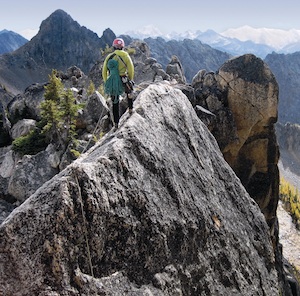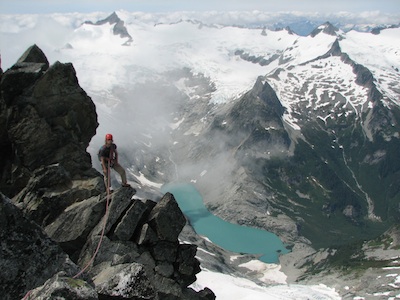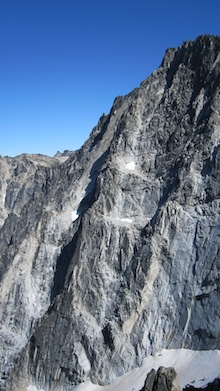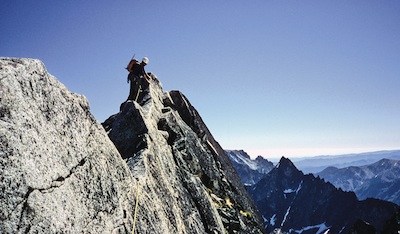Guided Alpine Rock Climbing in the North Cascades
Peaks and Routes
Moderate Ascents:
The ascents at this level are not highly technical, but the rock ascents involve multiple pitches. Participants should have some backcountry experience as well as basic rock experience for the rock ascents.
Washington Pass Alpine Rock Climbs:

The South Arete of the South Early Winter Spire offers superb climbing and splendid views of the surrounding Cascades. AAI Collection.
South Early Winter Spire, South Arete - Rock, 1 day
Often photographed, the Early Winter Spires and Liberty Bell stand out among the granite towers which cluster south of Washington pass. Although less well-known than routes on its famous neighbor to the north, this arete offers a satisfying ascent for less experienced climbers. Our approach takes us through a beautiful larch forest to the southernmost and highest rampart of the Liberty Bell massif. After a challenging 5.5 move early in the ascent, we enjoy stimulating, but moderate class 5 climbing with firm holds and increasing exposure on the way to the summit, where - from 7807 feet - we can trace the course of the Early Winters Creek some 2000 feet below and admire walls of Cascade peaks rising from the valley. Considered a fine introduction to the Liberty Bell towers, climbers frequently follow the South Arete with an ascent of the Beckey Route on Liberty Bell.
Liberty Bell, Beckey Route - Rock, 1 day
Long famous among the Northwest rock enthusiasts, the 7720-foot granite spire called Liberty Bell puts a variety of routes at our disposal. This route, up the Southwest Face, is a more sustained climb than the ascent on South Early Winter, but rock climbers who have had some experience (or who have just done the South Arete) will find it very rewarding. The slabs, cracks, and chimney on the route warrant a variety of techniques with moves up to 5.6, and every pitch is different. The summit affords broad views of this very photogenic alpine region.
Intermediate Ascents:
These ascents call for more technical skill than the moderate level climbs. Fisher Chimneys will challenge climbers who are still developing their technical skills, but who are thoroughly versed in the fundamentals of alpine technique. The rock routes on Forbidden and Triumph are more sustained, physically demanding, and exposed than either of the first two ascents listed here. All are exhilarating ascents of North American classics. For all these routes, you need to be able to perform well in a team, handle a rope with skill, and employ varied climbing techniques.
Mt. Shuksan, Fisher Chimneys - Rock, Snow and Ice, 3 days
Unique in many ways, Shuksan is one of the highest non-volcanic peaks in the Cascades, and it is among the most sought-after summits in North America. Like the Sulphide Glacier, Fisher Chimneys is a mixed route - climbers encounter snow, ice, and rock - but this is a longer, more advanced climb, and you should be comfortable on 4th class terrain. Our ascent follows a scenic glacier-carved valley to a little lake overlooking a spectacular basin. The climb first involves easy rock climbing in a series of chimneys, then moderate glacier climbing over parts of three different glaciers, and concludes with a 5.0 ascent of the summit pyramid.
Forbidden Peak, West Ridge - Rock, Snow and Ice, 3 days
Forbidden lies in the heart of the most glaciated area of the North Cascades and one of the most scenic regions of North America. Our ascent begins with a climb into Boston Basin directly across from the 5000' North Face of Johannesburg Mtn. Our route crosses a small glacier and then goes up a 500-foot ice filled couloir to gain the West Ridge. Then we follow the ridge crest on 4th and moderate 5th class rock to the summit with some exposure and spectacular views the whole way. This is a challenging rock climb in a rugged alpine setting. The rock is of high quality and the climbing on the exposed crest very enjoyable, making it easy to understand why the West Ridge is listed in the Fifty Classic Climbs of North America.

Climbing the picturesque West Ridge of Forbidden Peak with Eldorado in the background. Kurt Hicks
Mount Triumph, Northeast Ridge - Rock, Snow and Ice, 3 days
The aptly named Mount Triumph is one of the true crown jewels of the North Cascades, equally spectacular in shape and position. Rising like a rock dagger, it stands alone across Goodell Creek from the Picket Range, the most rugged and remote mountain range in the continental U.S. Our approach takes us first to a base at beautiful Thornton Lakes and then up gradually steepening ground to a high col. We cross a large, unnamed glacier to gain the base of the ridge which we ascend in a series of 5.0 to 5.6 pitches directly to the sculpted summit. Climb Triumph for a variety of classic alpine terrain and breathtaking views into the heart of the North Cascades.
Mount Goode, NE Buttress: Grade III+, 5.5. Rock and Glacier Travel, 3 days
We climb a striking line to the top of this remote 9,200-foot mountain. Though the climbing is mostly moderate, this is is a committing route, long and with 6,000 feet of relief from trailhead to summit. Located in North Cascades National Park, Mt. Goode is situated in the vicinity of many spectacular, high peaks, including Mt. Logan, Mt. Buckner, Dome Peak, and Bonanza Peak, and the views from the top are breathtaking.
Washington Pass Alpine Rock Climbs:
North Early Winter Spire, NW Corner: Grade III, 5.9+ - Rock, 1 day
Enjoy mostly crack climbing on super high-quality rock.
Burgundy Spire, North Face: Grade II+, 5.8 - Rock, 2 days
Enjoy spectacular views and high-quality climbing while on the route of this 8,400-foot peak. One of the Wine Spires (which also include Chianti, Pernod, and Chablis Spires), this climb is both sustained and challenging and finishes with a series of chimney and off-width cracks.
Difficult Ascents
These climbs require a complete repertoire of rock climbing skills and the ability to perform them consistently without error, as well as excellent physical condition. Technical requirements for rock climbs are listed individually.

The ridges of Dragontail Peak rise sharply from Colchuck Lake and offer spectacular climbing opportunities. Jason Martin
Dragontail Peak, Serpentine Arete - Rock, 2 or 3 days
Dominating the eastern rampart of the Stuart Range, 8840' Dragontail has become popular with climbers due to its sound rock and magnificent appearance. The Northwest Face in particular has been termed "one of the finest walls in the West." Serpentine Arete juts out of this face, a few hundred feet above Colchuck Glacier. Class 3 and 4 climbing takes us up to a pillar, and from there the route becomes more demanding and quite varied, with face climbing, liebacks, jamming, and finger cracks 5.7 to 5.8. The climb then eases off again for the final few pitches to the summit.
Forbidden Peak, NW Face of North Ridge or the NW Face - Rock, Snow and Ice, 3 days
These two climbs are among North America's finest alpine routes; both offer combinations of challenging rock and ice climbing. We approach both via Sharkfin Col, from which we rappel onto the Boston Glacier. Interesting route finding across this big glacier takes us to the lower North Ridge which we cross to reach the Forbidden Glacier. For the ascent of the NW Face of the North Ridge, we move to a point below the ridge, where we climb 1000 feet of 45-degree snow and ice. We then climb the ridge crest to the summit, enjoying moves up to 5.5. To reach the Northwest Face, we climb further up the Forbidden Glacier to gain the central spur of the NW Face. This impressive ridge runs 1700 feet directly to the summit with moves to 5.7. Both routes offer a classic combination of technical and mountaineering challenges in one of the continent's most rugged and remote alpine settings.
Mt. Stuart, North Ridge - Rock, Snow and Ice, 3 days
Like Forbidden, Stuart's North Ridge is a classic alpine rock climb, but unlike Forbidden, it lies east of the Cascade crest, in a more arid climate. Our route on this "monarch" of the Wenatchee Mountains takes us across a glacier and onto the ridge which rises almost 3000 feet above Mountaineer Creek. Here excellent granite provides secure holds, and we employ a variety of techniques among slabs, chimneys, couloirs, and gendarmes as we negotiate our way up. The upper route offers the choice of either 5.7 or 5.9 variations. Stuart's North Ridge is a long climb with steadily increasing exposure. The rewards of its technical challenges are matched by its summit's panoramic view of lakes, parklands, and peaks. Climbers can follow Forbidden with Stuart to make a spectacular week of alpine climbing.

A climber enjoying the phenomenal exposure on the N. Ridge of Mt. Stuart. AAI Collection
Washington Pass Alpine Rock Climbs:
South Early Winter Spire, East Buttress Direct: Grade IV, 5.10+ - Rock, 1 day
North Early Winter Spire, West Face: Grade III, 5.10, A1 Rock, 1 day
Chianti Spire, East Face: Grade III, 5.10 - Rock, 1 day
Very Difficult Ascents
These routes include some of the most exciting and challenging ascents in North American mountaineering. Climbers must be in excellent physical condition, possess advanced skills, and have significant previous alpine experience.
Dragontail Peak, Backbone Ridge - Rock, 2 or 3 days
East of the Serpentine Arete, this route takes us up the other prominent ridge on the Northwest Face. However, Backbone Ridge is a more demanding climb - we encounter a 90-foot, 6 inch crack which offers class 5.9 moves, as well as some class 5.9 face climbing. While effort is not sustained at 5.9 (there is also some class 4) it is a long ascent of some 21 pitches, and climbers should be ready to bivouac on the summit. Many climbers combine a route on Stuart with an ascent of Backbone Ridge for a satisfying week of advanced alpine rock climbing on the sound granite of the Stuart Range.
Mt. Stuart, Direct North Ridge - Rock, 3 days
This complete route on the North Ridge is more difficult than the climb in Level 4. Instead of traversing the Stuart Glacier, we approach directly to the base of the ridge and choose one of two variations to start up the rock. In either case climbers enjoy moves at class 5.7 or 5.8 before reaching the intersection with the standard North Ridge route. This ascent includes a bivouac on the ridge. The direct route is a sustained and rewarding ascent above the inspiring northern and eastern faces of this great mountain.
Big Wall Ascents
Liberty Bell, Liberty Crack - Rock, 2 or 3 days
The 1200-foot East Face of Liberty Bell is one of the finest big walls in the Pacific Northwest, and Liberty Crack is considered one of North America's classic routes. Climbing is very strenuous with moves up to 5.10. Two full days or more are required to complete the face (with the possibility of one hanging bivouac). The first several pitches are aid and the remaining ten are free climbing. Climbers should be able to lead 5.8 and have experience jumaring and cleaning aid. This is an exhilarating climb on a beautiful granite wall.
Liberty Bell, Thin Red Line: Grade V, 5.9, A3 - Rock, 2 or 3 days
Grand Wall (Squamish, British Columbia), Grade V, 5.10b, A1 - Rock, 2 days
University Wall (Squamish, British Columbia), Grade V, 5.10, A2 - Rock, 2 days